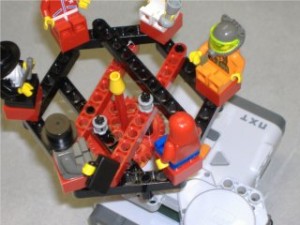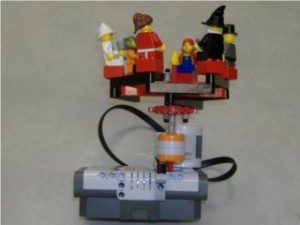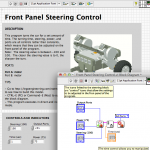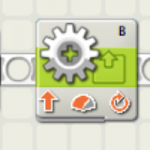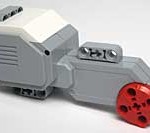In Part I of Motor vs. Move, we looked at how the Move block incorporates a control algorithm to help robots move more accurately. What else is different between the Motor and Move block in NXT-G?
Motor
The Motor block has an “Action” panel which includes a drop-down menu pertaining to how the robot’s motor will behave upon action.
Motor Block “Action” Programming Options
The “Constant” selection implies that the robot’s motor will perform at constant speed from when it is activated to when it is deactivated (as programmed). In other words, as soon as the program initiates motor action, the motor will spin at the power level that you specify in the “Power” panel. This feature is excellent for when your robot needs only to travel at a constant speed, or for such things as a clock that requires constant power in its motor.
The “Ramp Up” feature allows for the robot’s motor to approach the set power level as soon as the motor is activated. Once your program reaches the point that you set the motor to start, the motors will gradually increase in power from the stopped point until the motor reaches whatever percent power you have set. This “Ramp Up” feature allows your robot to act similarly to how your car accelerates when you press on the gas pedal.
The “Ramp Down” feature allows for the robot’s motor to slow in speed when approaching a stop. This feature does pertain to certain restrictions. This feature can only be used when the motor block is preceded with a motor block set with a constant speed set to coast after execution (see second block of the sample program below). This allows for an initial speed for the motors during the “ramped down” motor block. Once the motor is activated, it spins at the set power level, but as it approaches a stopped state, it will gradually decrease in power level. This closely mimics the braking of a vehicle. Without the preceding block, the “ramp down” motor block has an initial speed of zero, and hence will not be able to slow.
Sample Program
The second block must have an action of “Constant” and be set to coast
Note that all of the actions are only available if the Duration is set to rotations or degrees.
Move
The Move block does not contain any “Action” panel or the ability for you to specify how the motors will behave. This is due to the fact that there is already intelligence in the power component of the Move block (see Part I: The Control Algorithm). The built-in algorithm monitors rotation sensors on the NXT and slows the motor(s) as the robot approaches the target duration. Essentially, the Move block incorporates the “Ramp Down” feature of the Motor block.
Try it out: The merry-go-round
A Merry-go-round is a great application for the Move block’s “Ramp Up” and “Ramp Down” actions. Try them out by following the building and programming instructions in the Resources section.
By Ciera Maffei
Resources
CEEO
Latest posts by CEEO (see all)
- Chair for Mr Bear - 21 August 2020
- Assistive Technology: Making Lives Easier - 20 August 2020
- Sturdy Tower - 14 June 2020
- Going the Distance - 21 May 2020
- GPS accuracy testing with LEGO bricks - 10 September 2015


